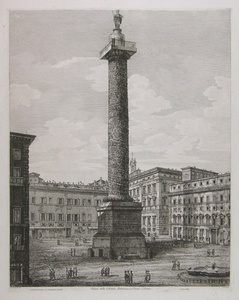| Method | Etching with engraving |
| Artist | Luigi Rossini |
| Published | Rossini dis. e inc. Roma 1823 |
| Dimensions | Image 555 x 445 mm, Plate 570 x 455 mm, Sheet 745 x 533 mm |
| Notes |
Inscription reads: 'A. Curia Innocenziana. B. Computisteria Camerale. C. Palazzo Ghigi.' Plate 4 from Le Antichita Romane, ossia Raccolta della piu interessanti Vedute di Roma Antica, depicting the so-called Antonine Column in the Piazza Colonna. To the right of the column are depicted the Curia Innocenziana, now the Palazzo Montecitorio, and the Palazzo Chigi. Both serve today as offices for the parliament of Italy, Montecitorio as the Chamber of Deputies, and the Chigi Palace as official residence of the Italian Prime Minister. The Antonine Column, more commonly referred to as the Column of Marcus Aurelius to avoid confusion with the Column of Antoninus Pius, was erected at the end of the 2nd century AD to celebrate Roman victory over the Marcomanni, Quadi, and Sarmatians. The column was modelled after the Column of Trajan, featuring a continuous band of relief carving depicting various scenes of military conquest and expressions of imperial power. The column was restored at the end of the sixteenth century by Pope Sixtus V, who added his own dedicatory inscription to the column's pedestal. A bronze statue of St Paul was also added to the top of the column at this time, to match a similar statue of St Peter that had been erected on the Column of Trajan. Le Antichita Romane, ossia Raccolta della piu interessanti Vedute di Roma Antica was Rossini's largest series of engravings, and the most popular with his clients. The 101 plates of views of the remains of Ancient Rome were completed between 1819 and 1823. The influence of Piranesi and the other great etchers of the 18th century is immediately apparent when looking at Rossini's work. In some cases, Rossini's perspectives match almost exactly those executed by Piranesi in the previous century, with an equal attention to architectural detail. As a result, the viewer is provided with a fascinating record of the changes wrought on Rome's most famous monuments in the time between the two artists. Luigi Rossini (1790-1857) was an Italian painter and etcher. Born in Ravenna, he studied art and architecture at the Academy of Bologna with Antonio Giuseppe Basoli and Giovanni Antonio Antolini. He graduated in 1813. Similarly to Giovanni Battista Piranesi, Rossini is best known for etchings of classical Roman architecture including the Pantheon, the Colosseum, the Appian Way, the Temple of Peace, and the Golden House of Nero. Rossini was also influenced by more rural settings, and produced etchings of the landscape surrounding Rome. His first series of views were published in 1814. He began his Roman antiquities series in 1819, completing 101 large folio plates which were published in Rome in 1825. Condition: Excellent clean impression. Light staining to edges of sheet, not affecting plate or image. |
| Framing | unmounted |
| Price | £875.00 |
| Stock ID | 31344 |

